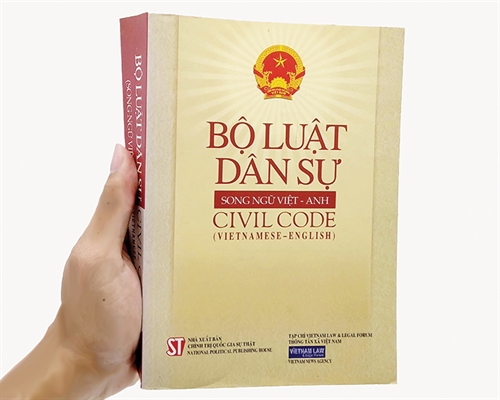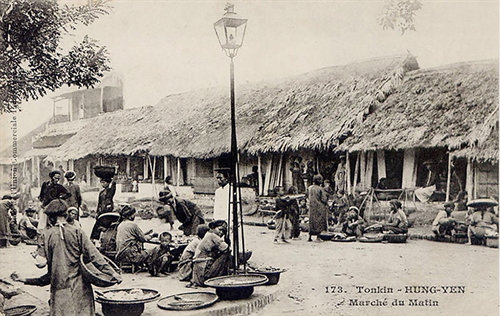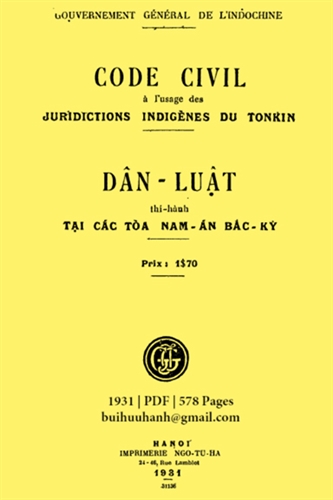Tran Hong Nhung, LL.D. Hanoi Law University
 |
| Hoang Viet Luat Le (The Royal Laws and Regulations of Vietnam)__Photo: https://vi.m.wikipedia.org |
Lawmaking under the Nguyen dynasty was given special prominence by various kings from Gia Long to Tu Duc with many laws and regulations diverse in form and rich in content. Typical among them was Hoang Viet Luat Le (The Royal Laws and Regulations of Vietnam), the most comprehensive ancient code in Vietnam. It was compiled in two years (1811-1812) and enacted in 1815 under King Gia Long’s reign, hence usually called in historical records as Gia Long Code.
Hoang Viet Luat Le was structured in 22 volumes with 398 articles arranged into seven chapters. The appellations and contents of these chapters were initiated after the names and functions of six ministries: Binh (in charge of military affairs), Cong (in charge of public facilities, irrigation, construction of mausoleums, tombs…), Hinh (in charge of legal affairs and adjudication), Le (in charge of education, cultural activities and health), Lai (in charge of organization and personnel affairs), and Ho (in charge of finance, tax, civil status, management).
Chapter 1: Danh Le dealt with matters governing other chapters and articles, with regulations on “ngu hinh” (five criminal penalties), and “thap ac” (ten grave offenses), “bat nghi” (eight wishes).
Chapter 2: Luat Lai (organization and personnel law) stipulated groups of position-related offenses
Chapter 3: Luat Ho provided mainly the civil status, household registration, marriage and family, ownership, contracts, and inheritance.
Chapter 4: Luat Le mainly regulated ceremonies, rites, rituals, etc.
Chapter 5: Luat Binh defined groups of security and military offenses.
Chapter 6: Luat Hinh prescribed criminal offenses such as burglaries, murders, fighting, corruption, and procedural regulations.
Chapter 7: Luat Cong defined groups of crimes in construction of public facilities.
Hoang Viet Luat Le had a special structure and King Gia Long gave his last instruction not to revise the code. Facing numerous socio-economic changes, in order not to go against the King’s last will, the feudal lawmakers then supplemented every article with one or more regulations to explain it.
Regarding legislative techniques, as a general code, Hoang Viet Luat Le regulated almost all basic social relations in various domains, from criminal offenses, marriage and family, civil transaction, to legal proceedings. It contained 45 articles for Chapter 1 (Danh Le), 27 articles for Chapter 2 (Luat Lai), 66 articles for Chapter 3 (Luat Ho), 26 articles for Chapter 4 (Luat Le), 58 articles for Chapter 5 (Luat Binh), 166 articles for Chapter 6 (Luat Hinh), 10 articles for Chapter 7 (Luat Cong). This is the common legislative technique of pre-capitalist nations.
Law interpretation was given prominence in the compilation of Hoang Viet Luat Le. The feudal legislators added explanations to almost every article, helping readers understand and apply the law more clearly and easily. This technique was demonstrated in such forms as clarifying the concepts in the law.
Right in the Code’s Foreword, the lawmakers clearly explained the concepts used in the law such as “Luc tang do” (diagram of six types of material evidence) enclosed with diagrams of offenders, including “giam thu” (burglar), “toa tang” (receiving or trading material evidence), “uong phap” (money swindle), etc., which was accompanied with diagrams on penalties.
The above-mentioned concepts were also accompanied with clarifying notes. For instance, the provision on “Luc tang do” was added with three notes, explaining cases of offense and punitive levels for each offender, depending on the number of collected material evidence. Under this Code, corrupted mandarins as well as burglars who did great harms to people, must be severely punished.[1]
The notes on a number of provisions aimed to add contents not covered by the law. For example, the note on “Le chuoc toi” (Regulations on bail) set out five penalties: “danh roi” (whipping), “danh truong” (heavy wood stroke), “do” (hard labor), “luu day” (exile), and “xu tu” (death penalty), which were eligible for bail. As the law and regulations failed to specify cases eligible and ineligible for bail, the notes helped settle the matter.
Comparison was used in law explanations for clearer understanding. For instance, the concept “Tinh tang luan toi” (Counting material evidences to determine offenses) was defined by the law as counting the material evidences to determine penalties and also by comparison with the casting of gold, silver or copper for easier understanding of the meaning of this concept.[2]
The legislators also included application guidelines in the law explanation notes. For instance, after the explanation of “Tinh tang luan toi”, the law additionally said: “Although the law so provides, the application to adjudication falls into two different cases: If the material evidences were stolen at different times, all the material evidences were summed up for determination of offenses, that was the first case. If the stolen material evidences do not belong to a single owner and are detected simultaneously, only the material evidences of the largest owner were counted for determination of offenses, that is the second case”.[3]
For a number of articles, the question-answer technique was used for interpretation. For example, in Section “Tinh tang luan toi”, an article wrote: “Some people ask why thieves, burglars and robbers are actually the same, but only robbers are classified into culprits and accomplices? Answer: Private assets of individuals are carefully kept, one person cannot steal them. In order to steal such property, robbers must together discuss plans, send spies to discretely observe the situation, and later carry the stolen assets for storage. So, if there are no accomplices, the culprits themselves cannot perform all such tasks. Hence, offenders are classified into culprits and accomplices…”[4]
Following the explanations and discussions on different concepts and principles in the introduction section, the articles in seven chapters of the Code were all accompanied by regulations which further clarified the contents of the articles.
Article 19 provided: “Where women are penalized with strokes of heavy wood sticks, if they commit adultery, they shall be punished by stripping off all clothes, excluding loins. For other offenses, they are allowed to only wear thin shirts. All are exempted from letter carving. If they are sentenced to hard labor or exile, they shall be punished with 100 strokes of heavy wood sticks instead of hard labor and exile”.
The regulations accompanying this article explained: “Women who commit adultery lose their shame. Punishing them by stripping off all clothes, excluding loins, or allowing them to only wear thin shirts for other offenses will deter them. Women who are sentenced to hard labor or exile shall be remitted to 100 strokes of heavy wood sticks because they could not stand hard labor or exile”.
Being the last code of Vietnamese monarchies, Hoang Viet Luat Le was evaluated as more modern in legislative techniques than the Le dynasty. The law interpretation and legislative techniques in this Code should be studied more thoroughly as a valuable reference for Vietnam’s current legislative activities.-
[1] The History Institute (2009), Vietnamese ancient law, “Quoc Trieu Hinh Luat” (the National Royal Criminal Law) and “Hoang Viet Luat Le”, Education Publishing House, Hanoi, p. 204.
[2] Ibid. p. 206.
[3] Ibid, p. 206.
[4] Ibid, p. 207.









